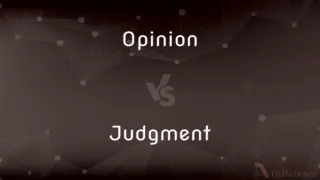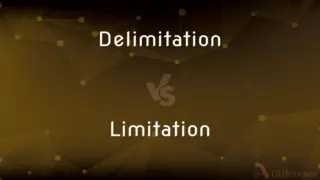Dupatta vs. Hijab — What's the Difference?
By Urooj Arif & Fiza Rafique — Updated on March 25, 2024
A dupatta is a traditional South Asian scarf, used for modesty and style, while a hijab is a head covering worn by Muslim women for modesty and religious reasons.
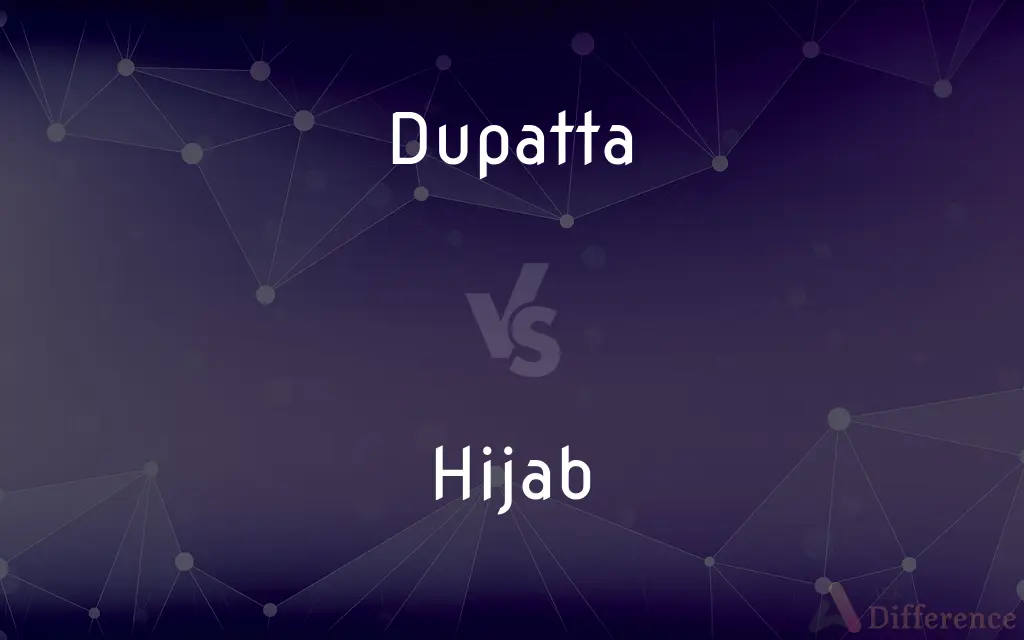
Difference Between Dupatta and Hijab
Table of Contents
ADVERTISEMENT
Key Differences
The dupatta is a long, multi-purpose scarf traditionally worn by women in South Asia. It serves both as a fashion accessory and a symbol of modesty, often draped over the head and shoulders. Whereas the hijab is specifically a headscarf worn by Muslim women around the world as a sign of modesty and privacy, and it fulfills a religious obligation in Islam.
While the dupatta is part of traditional South Asian attire, complementing outfits like salwar kameez and lehengas, the hijab is worn with a wide range of clothing styles, both traditional and modern, depending on personal choice and cultural influences. On the other hand, hijabs are selected to comply with Islamic guidelines of modesty, often covering the head and chest.
The material, design, and styling of a dupatta can vary greatly, from simple cotton fabrics for everyday use to heavily embellished ones for weddings and special occasions. Meanwhile, hijabs are also available in various materials and styles, but the primary focus remains on modesty, with less emphasis on embellishment compared to dupattas.
In cultural significance, the dupatta holds a place in various South Asian rituals and ceremonies, symbolizing respect and modesty. On the other hand, the hijab carries a religious significance for Muslim women, representing their faith and commitment to Islamic principles.
Fashion trends and personal preferences heavily influence the styling of a dupatta, which can be worn in numerous ways. Hijabs, while also adaptable to some fashion trends, adhere to more specific guidelines on how they should cover the hair and body, reflecting a balance between personal identity and religious adherence.
ADVERTISEMENT
Comparison Chart
Primary Use
Fashion accessory and modesty
Religious observance and modesty
Cultural Origin
South Asia
Islamic countries worldwide
Worn With
Salwar kameez, lehengas, and other attire
Any clothing, traditional or modern
Material & Design
Varies widely, from cotton to silk with embellishments
Typically simple, focusing on modesty
Significance
Cultural and traditional
Religious and modesty
Compare with Definitions
Dupatta
Used in various ceremonies for cultural significance.
During the wedding, she wore a heavily embroidered dupatta.
Hijab
Fulfills a religious duty in Islam.
Wearing a hijab is part of her religious observance.
Dupatta
A long scarf used for modesty and style in South Asia.
She draped her dupatta over her shoulders elegantly.
Hijab
Can be paired with various clothing styles.
She wears her hijab with both traditional and Western clothes.
Dupatta
Part of traditional attire, often matching with outfits.
Her dupatta matched her salwar suit perfectly.
Hijab
Focuses on covering the head and chest.
Her hijab was draped carefully to cover her hair and chest.
Dupatta
Material ranges from simple cotton to luxurious silk.
For daily wear, she prefers a lightweight cotton dupatta.
Hijab
Reflects a balance between modesty and personal style.
Her hijab collection includes a range of colors and fabrics.
Dupatta
Can be styled in numerous ways for fashion.
She styled her dupatta in a modern twist for the party.
Hijab
A headscarf worn by Muslim women for modesty.
She chose a hijab that complemented her outfit.
Dupatta
The dupattā is a shawl traditionally worn by women in South Asia. The dupatta is currently used most commonly as part of the women's shalwar kameez outfit, and worn over the kurta and the gharara.
Hijab
A hijab (; Arabic: حجاب, romanized: ḥijāb, pronounced [ħɪˈdʒaːb] in common English usage) is a religious veil worn by Muslim women in the presence of any male outside of their immediate family, which usually covers the hair, head and chest. The term can refer to any hair, head, face, or body covering worn by Muslim women that conforms to Islamic standards of modesty.
Dupatta
A long wide scarf often worn draped over the head or across the shoulders, chiefly by women in South Asia.
Hijab
Any of several cloth head coverings worn by Muslim women.
Dupatta
(South Asia) A double layer of cloth worn by women as a scarf, veil etc.
Hijab
The veiling of women in some Islamic societies, customarily practiced in order to maintain standards of modesty.
Hijab
(countable) A traditional headscarf worn by Muslim women, covering the hair and neck.
Hijab
A headscarf worn by Muslim women; conceals the hair and neck and usually has a face veil that covers the face
Hijab
The custom in some Islamic societies of women dressing modestly outside the home;
She observes the hijab and does not wear tight clothing
Common Curiosities
Is wearing a hijab compulsory in Islam?
Yes, for many Muslims, wearing a hijab is a religious obligation that signifies modesty and devotion.
Can the hijab be worn with non-traditional attire?
Yes, hijabs can be styled with a wide range of outfits, from traditional to modern Western wear.
Can a dupatta be used as a hijab?
Yes, a dupatta can be styled to serve as a hijab if it covers the hair and chest, adhering to the modesty requirements.
What occasions are dupattas worn for?
Dupattas are worn for both daily wear and special occasions, like weddings and religious ceremonies.
Is there a cultural significance to the dupatta?
Yes, beyond fashion, the dupatta holds cultural and traditional importance in South Asian societies.
How are dupattas and hijabs similar?
Both serve the purpose of modesty, can be made from a variety of materials, and are significant to their respective cultures.
How do personal preferences influence the choice between a dupatta and hijab?
Personal preferences, cultural background, and religious beliefs all play a role in whether one wears a dupatta, a hijab, or both.
What is the main difference between a dupatta and a hijab?
The dupatta is a traditional South Asian scarf worn for style and modesty, while the hijab is a headscarf worn by Muslim women primarily for religious reasons.
How do modern fashion trends impact the styles of dupattas and hijabs?
Fashion trends influence the materials, designs, and ways both are styled, with adaptations to reflect contemporary tastes while respecting cultural and religious norms.
Do hijabs come in different styles?
Yes, hijabs come in various styles, colors, and fabrics, allowing for personal expression while maintaining modesty.
Do the patterns on a dupatta have any specific meanings?
Some traditional patterns may represent cultural stories or symbols, but many modern designs focus on aesthetic appeal.
Are there specific colors preferred for hijabs?
While there are no specific rules on colors, many prefer modest, neutral tones, though personal choice and fashion also play a role.
Can the material of a hijab affect its appropriateness?
Yes, the material should ensure proper coverage and comfort, adhering to the principles of modesty.
What role does the dupatta play in South Asian weddings?
The dupatta is often elaborately designed for weddings, serving as a significant part of the bridal attire.
Why is the hijab seen as a symbol of identity among Muslim women?
The hijab represents a conscious commitment to faith and modesty, making it a key aspect of personal and religious identity.
Share Your Discovery
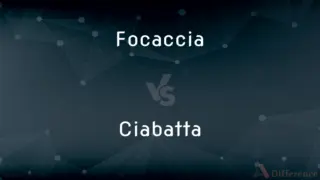
Previous Comparison
Focaccia vs. Ciabatta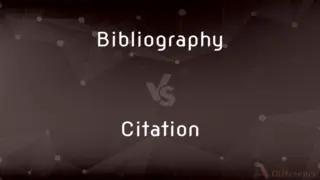
Next Comparison
Bibliography vs. CitationAuthor Spotlight
Written by
Urooj ArifUrooj is a skilled content writer at Ask Difference, known for her exceptional ability to simplify complex topics into engaging and informative content. With a passion for research and a flair for clear, concise writing, she consistently delivers articles that resonate with our diverse audience.
Co-written by
Fiza RafiqueFiza Rafique is a skilled content writer at AskDifference.com, where she meticulously refines and enhances written pieces. Drawing from her vast editorial expertise, Fiza ensures clarity, accuracy, and precision in every article. Passionate about language, she continually seeks to elevate the quality of content for readers worldwide.


















